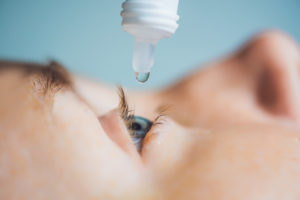May 1, 2020
By Laura Kirkeby, CO

The use of atropine has been known to slow the progression of myopia for many years.1.2 Initially, approved concentrations of atropine (0.5 percent to 1 percent) were prescribed, resulting in significant and prolonged pupillary mydriasis and accommodative paralysis..2,3,4 Due to these side effects, commercially available atropine was not widely prescribed as a primary treatment modality to slow myopic progression.
Fast forward more than 50 years, and we find that lower concentrations of atropine have similar results for reducing myopic progression (efficacy) but significantly reduce adverse effects including increased pupil diameter and decreased accommodation and near visual acuity.,5,6,7 In fact, randomized controlled trials have now demonstrated that 0.01 percent atropine is nearly as effective at slowing myopic progression at higher doses with less rebound effect and minimal side effects.5,7 The ATOM 2 study found that atropine 0.01 percent increased pupil diameter by 1mm and reduced accommodation by 2.00D to 3.00D.6 A recent study published by Fu et al. had similar results for atropine 0.01 percent, with an increase in pupil mydriasis of 0.74mm and a 2.00D to 3.00D decrease in accommodation.8 Several randomized studies have demonstrated that minimal changes to pupil diameter and accommodative amplitude found in patients treated with 0.01 percent atropine are not associated with decreased near vision or reading difficulties.5,6, 7
Following up on the initial excitement of using low-dose atropine (which in some minds specifically refers to 0.01 percent), many ophthalmologists and optometrists are finding that a subset of patients using 0.01 percent continues to show significant myopic progression. We now find ourselves asking if some patients might benefit from slightly higher concentrations of atropine to slow their progression. An increased “low-dose” atropine regimen has not yet been standardized among eye care providers with current ranges spanning from 0.02 percent to 0.1 percent. A study by Fu et al. compared the effects of 0.01 percent and 0.02 percent on myopic progression, pupil diameter, and accommodation.8 They found that 0.02 percent atropine was slightly more effective in reducing myopic progression than 0.01 percent with no significant differences in pupil size or accommodation between groups. In both groups, a small proportion of children reported mild decreased near vision for two to three weeks after initiating treatment. The LAMP study examined three concentrations of atropine and found a dose-dependent response for pupil dilation and decreased accommodation.7 They found that 0.025 percent atropine was associated with an increased pupil diameter of 0.76mm, while 0.05 percent increased pupil diameter by 1.03 mm. They also reported a mild decrease in accommodation of 1.40D and 2.10D for children using 0.025 percent and 0.05 percent atropine, respectively. These findings are similar to those reported by Fu et al. and the ATOM 2 study.6,8 There were no changes in distance or near visual acuity for all three groups, and a quality of life questionnaire showed no difference in subjective visual abilities.
Joachimson et al. reported pilot data on atropine 0.01 percent in a single-center cohort of children of European ancestry, collected in preparation for a larger randomized clinical trial. The researchers concluded that 0.01 percent topical low-dose atropine appears to be safe and efficacious in a cohort of European schoolchildren.9
A summary of these findings is listed in table 1.
Table 1 Change in pupil diameter, accommodation, and near vision in response to different concentrations of topical atropine.
| Concentration of Atropine (percent) | Change in Photopic Pupil Diameter (mm) | Change in
Accommodation (D) |
Near Visual Acuity
(while using atropine) |
|
| Chia et al. (Atom Phase 2) Singapore | 0.01 | 0.74 | 4.60 | 20/20 |
| 0.10 | 2.25 | 10.1 | 20/25 | |
| 0.50 | 3.11 | 11.8 | 20/30 | |
| Chia et al. (Atom Phase 3)
Singapore |
0.01 | 1.00 | 2.00 to 3.00 | no effect |
| Fu et al.
China
|
0.01 | 0.74 | 2.00 to 3.00 | not reported |
| 0.02 | 0.89 | 2.00 to 3.00 | not reported | |
| Yam et al. LAMP Study Hong Kong | 0.01 | 0.49 | 0.50 | 20/20 |
| 0.025 | 0.76 | 1.40 | 20/20 | |
| 0.05 | 1.03 | 2.11 | 20/20 | |
| Joachimsen et al. Germany | 0.01 | 1.00 | 2.00 | no effect |
On the other hand, increasing atropine to 0.1 percent has been shown to have a significant impact on visual function in children.5 Chia et al. found that 0.1 percent atropine was associated with an increased pupil diameter of 2mm and a 10.00D decrease in accommodation.5 Although the near visual acuity in this group was only reduced to 20/25, 61 percent of children in this group requested progressive lenses.
It appears that atropine concentrations of 0.05 percent or lower do not significantly impact visual function and may end up being the high end of acceptable concentrations for patients who do not appear to benefit from 0.01 percent. However, as shown in the ATOM 2 study, minimal changes to near vision may not be indicative of visual discomfort.5 When prescribing daily low-dose atropine at any dose, it is important to ask patients if they are experiencing changes to reading ability and visual function.
We prescribe a variety of concentrations of low-dose atropine, including 0.01 percent and 0.03 percent. In our clinical experience, very few of our patients using either concentration of atropine have reported adverse visual symptoms. Although rare, some patients experience a small increase in pupil diameter (which does not appear to be associated with ethnicity or iris pigmentation). We have also found that patients who do report slight mydriasis do not necessarily experience symptoms of photophobia, decreased vision, or trouble focusing on nearby objects. To date, the frequency of mild pupil mydriasis appears to be the same for patients using either 0.01 percent or 0.03 percent atropine concentrations. When tested in our clinic, the visual acuity of these patients at distance and near, as well as their accommodative amplitudes have been within normal limits. Until the industry settles on recommended or FDA-approved, low-dose atropine concentrations (based on data generated from large prospective randomized clinical trials), proper management of dosage and side effects must be considered.
 Laura Kirkeby, CO, is an orthoptist and clinical researcher at Scripps Clinic in San Diego, California. She is currently the vice president of the American Association of Certified Orthoptists and past president of the Canadian Orthoptic Society.
Laura Kirkeby, CO, is an orthoptist and clinical researcher at Scripps Clinic in San Diego, California. She is currently the vice president of the American Association of Certified Orthoptists and past president of the Canadian Orthoptic Society.
This article is sponsored in part by the Global Myopia Awareness Coalition (GMAC). GMAC’s mission is to promote public awareness of childhood myopia as a treatable disease while educating parents about safe and effective treatment options.
Footnotes
1 Gimbel HV. The control of myopia with atropine. Can J Ophthalmol 1973;8:527-532.
2 Gwiazda J. Treatment options for myopia. Optom Vis Sci 2009;86:624-628.
3 Chou AC, Shih YF, Ho TC, Lin LL. The effectiveness of 0.5% atropine in controlling high myopia in children. J Ocul Pharmacol Ther 1997;13:61-67.
4 Chua WH, Balakrishnan V, Chan YH, Tong L, Ling Y, Quah BL, Tan D. Atropine for the treatment of childhood myopia. Ophthalmology. 2006;113:2285–2291.
5 Chia A, Chua W-H, Cheung Y-B, et al. Atropine for the treatment of childhood myopia: safety and efficacy of 0.5%, 0.1%, and 0.01% doses (Atropine for the Treatment of Myopia 2). Ophthalmology 2012;119:347–354.
6 Chia A, Lu Q-S, Tan D. Five-Year Clinical Trial on Atropine for the Treatment of Myopia 2: Myopia Control with Atropine 0.01% Eyedrops. Ophthalmol 2016;123;391-399.
7 Yam JC, Jiang Y, Tang SM, et al. Low-Concentration Atropine for Myopia Progression (LAMP) Study: a randomized, double-blinded, placebo-controlled trial of 0.05%, 0.025%, and 0.01% atropine eye drops in myopia control. Ophthalmology 2019;126:113-124.
8 Fu A, Stapleton F, Wei L et al. Effect of low-dose atropine on myopia progression, pupil diameter and accommodative amplitude: low-dose atropine and myopia progression. Br J Ophthalmol 2020;0;1-7.
9 Joachimsen, L., Böhringer, D., Gross, N. J., Reich, M., Stifter, J., Reinhard, T., & Lagrèze, W. A. (2019). A pilot study on the efficacy and safety of 0.01% atropine in German schoolchildren with progressive myopia. Ophthalmology and therapy, 8(3), 427-433.













